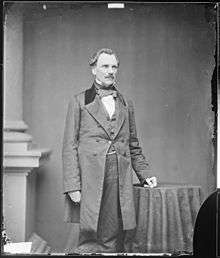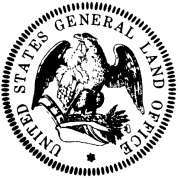James Shields (politician, born 1810)
| James Shields | |
|---|---|
 | |
| United States Senator from Missouri | |
|
In office January 27, 1879 – March 3, 1879 | |
| Preceded by | David H. Armstrong |
| Succeeded by | George Graham Vest |
| United States Senator from Minnesota | |
|
In office May 11, 1858 – March 3, 1859 | |
| Preceded by | None |
| Succeeded by | Morton S. Wilkinson |
| United States Senator from Illinois | |
|
In office October 27, 1849 – March 3, 1855 | |
| Preceded by | Sidney Breese |
| Succeeded by | Lyman Trumbull |
| Member of Illinois House of Representatives | |
|
In office 1836 | |
| Personal details | |
| Born |
May 10, 1810 Altmore, County Tyrone, Ireland |
| Died |
June 1, 1879 (aged 69) Ottumwa, Iowa |
| Nationality | American |
| Political party | Democratic |
| Military service | |
| Service/branch |
United States Army Union Army |
| Years of service | 1846–1848; 1861–1862 |
| Rank |
|
| Battles/wars |
Mexican–American War American Civil War |
James Shields (May 10, 1810 – June 1, 1879) was an Irish American Democratic politician and United States Army officer, who is the only person in United States history to serve as a U.S. Senator for three different states. Shields represented Illinois from 1849 to 1855, in the 31st, 32nd, and 33rd Congresses, Minnesota from 1858 to 1859, in the 35th Congress, and Missouri in 1879, in the 45th Congress. He also served as Illinois Auditor of Public Accounts from 1841 to 1843 and as Commissioner of the General Land Office from 1845 to 1847.
Biography
Early life and career
A descendant of the Ó Siadhail clan, Shields was born in Altmore, County Tyrone, in what is now Northern Ireland. His uncle, also named James Shields and also born in Ireland, was a Congressman from Ohio. The younger Shields immigrated to the United States around 1826 and settled in Kaskaskia, Randolph County, Illinois where he studied and later practiced law.[1] He served as a member of the Illinois House of Representatives, beginning to serve in 1836, and then as an Illinois Supreme Court justice and in 1839 as the state auditor. (He was elected when not yet a citizen; Illinois then required only that a legislator have been resident in the state for six months.)
Duel with Abraham Lincoln
Shields almost fought a duel with Abraham Lincoln on September 22, 1842. Lincoln had published an inflammatory letter in a Springfield, Illinois, newspaper, the Sangamon Journal that poked fun at Shields, the State Auditor. Lincoln's future wife, Mary Todd, and her close friend continued writing letters about Shields without Lincoln's knowledge. Taking offense to the articles, Shields demanded "satisfaction" and the incident escalated to the two parties meeting on an island located between Missouri and Illinois called Bloody Island to participate in a duel (as dueling was illegal in Illinois and the island was under Missouri jurisdiction).[2] Lincoln took responsibility for the articles and accepted the duel. Lincoln had the opportunity to choose the weapon for the duel and he selected the cavalry broadsword, as Shields was an excellent marksman. Just prior to engaging in combat, Lincoln made it a point to demonstrate his advantage (because of his long arm reach) by easily cutting a branch just above Shields' head. The two participants' seconds intervened and were able to convince the two men to cease hostilities, on the grounds that Lincoln had not written the letters.[3][4]


Mexican–American War
Subsequently, Shields served as a Judge of the Illinois Supreme Court, and as Commissioner of the U.S. General Land Office. On July 1, 1846, he was commissioned a brigadier general of volunteers to fight in the Mexican–American War. He served under Zachary Taylor along the Rio Grande. He commanded the 3rd Brigade, Volunteer Division, at the battles of Vera Cruz and Cerro Gordo, where he was wounded. He returned to fight at the battles of Contreras and Churubusco, his brigade now part of the 4th Division. He was again wounded at the Battle of Chapultepec.
Senator from Illinois
Following the war, on August 14, 1848, he was nominated by President Polk, and confirmed by the United States Senate to serve as governor of Oregon Territory that was created that same day.[5] However, he declined the position and Joseph Lane was nominated and became the first governor of the new territory.[6] He resigned to run for the Senate from Illinois. His election was voided by the Senate on the grounds that he had not been a United States citizen for the nine years required by the United States Constitution; having been naturalized October 21, 1840. He returned to Illinois and campaigned for re-election, and won the special election to replace himself, and was then seated.
He was the editor of the 1854 book, A History of Illinois, from its Commencement as a State in 1818 to 1847.
A bronze statue of Shields, in the uniform of a Major General, was given by the State of Illinois in 1893 to the U.S Capitol. The statue is the work of artist Leonard W. Volk, and is displayed the Hall of Columns. [7]
Senator from Minnesota
In 1855, he was defeated for re-election so he moved to Minnesota to inspect some lands he had been awarded there in return for his military service. He arranged for Irish immigrants to move from the east coast to Minnesota, settling in Rice and Le Sueur counties. Shields himself founded Shieldsville, Minnesota and was also involved in the early settlement of Faribault, Minnesota. When Minnesota achieved statehood in 1858, Shields was put forward as a compromise candidate for US Senator along with Henry Mower Rice. The two drew straws to determine who would serve out the longer and shorter terms. Shields drew the short straw and thus served only a year from 1858 to 1859, losing his re-election bid to Morton S. Wilkinson.[8]
American Civil War
Shields then moved to California and served as a brigadier general of volunteers from that state during the American Civil War. He commanded the 2nd Division of the V Corps, Army of the Potomac (subsequently part of the Army of the Shenandoah), during the Valley Campaign of 1862. He was wounded at the Battle of Kernstown on March 22, 1862, but his troops inflicted the only tactical defeat of General Thomas J. "Stonewall" Jackson during the campaign (or the war). The day after Kernstown, he was promoted to major general, but the promotion was withdrawn, reconsidered, and then finally rejected. His overall performance in the rest of the Valley Campaign was poor enough that he resigned his commission, and his departure was not resisted by the War Department.
Senator from Missouri
In 1863 he moved to Mexico and operated mines, and then to Wisconsin, but in 1866 moved to Missouri, where he served as member of the Missouri State House of Representatives, and as railroad commissioner. In 1879, he was elected to fill the seat left vacant by the death of Senator Lewis V. Bogy. He served only three months and declined to run for re-election.
Death
Shields died in Ottumwa, Iowa on June 1, 1879. He is buried in St. Mary's Cemetery, Carrollton, Missouri. He represents Illinois in the National Statuary Hall.
See also
- List of American Civil War generals

Wikisource has original text related to this article:
Notes
- ↑
 Herbermann, Charles, ed. (1913). "James Shields". Catholic Encyclopedia. New York: Robert Appleton Company.
Herbermann, Charles, ed. (1913). "James Shields". Catholic Encyclopedia. New York: Robert Appleton Company. - ↑ "Abraham Lincoln's Duel: Broadswords and Banks"
- ↑ "Abraham Lincoln Prepares to Fight a Saber Duel", originally published by Civil War Times magazine
- ↑ Ronald C. White, Jr. (2009). A. Lincoln: A Biography. Random House Digital, Inc. pp. 115–.
- ↑ Senate Executive Journal: Monday, August 14, 1848. Library of Congress, retrieved September 13, 2007.
- ↑ Senate Executive Journal: Tuesday, December 12, 1848. Library of Congress, retrieved September 13, 2007.
- ↑ https://www.aoc.gov/art/national-statuary-hall-collection/james-shields
- ↑ Castle, Henry Anson (1915). General James Shields: Soldier, Orator, Statesman. Minnesota Historical Society.
References
- Eicher, John H., and Eicher, David J., Civil War High Commands, Stanford University Press, 2001, ISBN 0-8047-3641-3.
External links
- United States Congress. "James Shields (id: S000362)". Biographical Directory of the United States Congress.
- Works by or about James Shields at Internet Archive
| Political offices | ||
|---|---|---|
| Preceded by Levi Davis |
Illinois Auditor of Public Accounts 1841–1843 |
Succeeded by William Lee D. Ewing |
| Government offices | ||
| Preceded by Thomas H. Blake |
Commissioner of the General Land Office April 16, 1845 – January 6, 1847 |
Succeeded by Richard M. Young |
| United States Senate | ||
| Preceded by Sidney Breese |
U.S. Senator (Class 3) from Illinois October 27, 1849 – March 3, 1855 Served alongside: Stephen A. Douglas |
Succeeded by Lyman Trumbull |
| Preceded by None |
U.S. Senator (Class 2) from Minnesota May 11, 1858 – March 3, 1859 Served alongside: Henry Mower Rice |
Succeeded by Morton S. Wilkinson |
| Preceded by David H. Armstrong |
U.S. Senator (Class 3) from Missouri January 22, 1879 – March 3, 1879 Served alongside: Francis M. Cockrell |
Succeeded by George G. Vest |


